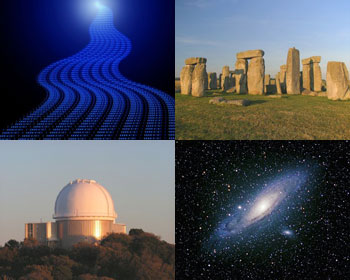A Publication of the
Applied Math and Science Education Repository

The AMSER Science Reader Monthly aims to provide educators with a useful package of information about a particular topic related to applied math and science by combining freely available articles from popular journals with curriculum, learning objects, and web sites from the AMSER portal. The AMSER Science Reader Monthly is free to use in the classroom and educators are encouraged to contact AMSER with suggestions for upcoming issues or comments and concerns at [email protected].
This month's AMSER Science Reader Monthly topic is Astronomy & Informatics.
When Astronomy Met Computer Science
Article
by Preston Lerner
Synopsis and resource annotations by Max Grinnell

In the past, astronomers struggled to analyze all the data they collected each time they looked at the night sky. However, with the arrival of new telescopes and computers, today's sky surveys can catalog billions of astronomical objects. This article by Preston Lerner originally appeared in the April 2011 issue of Discover Magazine, and it takes a close look at the ways in which computer science and informatics have informed major developments in astronomical data collection.
The piece begins by talking about the work of researcher and professor Kirk Borne, who was employed at NASA's National Space Science Data Center in Greenbelt, Maryland. Another astronomer asked if the Center could archive a terabyte of data that had been collected by a prominent sky survey. After talking with his boss, who was a bit incredulous, he realized that they "needed to do something not only to make all that data available to scientists but also to enable scientific discovery from all that information."
The piece moves on to discuss how, over the past eleven years, the Sloan Digital Sky Survey at the Apache Point Observatory in New Mexico has imaged over one-third of the night sky. The computational analysis from this tremendous data set has uncovered evidence of little-known astronomical objects, and it has also mapped out the three-dimensional structure of the local universe. More sky surveys are continuing across the world, and they include the work done by the Large Synoptic Survey Telescope in Chile. The camera inside this instrument will be able to capture an area 49 times as large as the moon in each 15-second exposure when it is operational in 2019.
While all of this data could prove quite useful, there remains one possible problem: data deluge. As Professor George Djorgovski, an astronomy professor at CalTech commented, "For the first time in history, we cannot examine all of our data. The challenge is to develop a new scientific methodology for the 21st century." The key component of such a methodology will be the data-crunching technique known as informatics, which is the use of computers to extract meaning from raw data too complex for the human brain to analyze. By developing astroinformatics, computers can assist astronomers by doing what they have done for centuries in a greatly reduced timeframe. These algorithms can scour terabytes of data in seconds, highlight patterns and anomalies, visualize key information, and even "learn" on the job. For example, astroinformatics will help astronomers search more methodically for extreme or "unusual" objects, such as high-redshift quasars, which are extremely distant and luminous objects powered by supermassive black holes. Additionally, astronomers are now using algorithms to look over some of these image data sets to estimate an object's distance. The piece concludes by offering links to some exciting astronomy projects, such as the Galaxy Zoo, which uses volunteers to help classify images from the Sloan Digital Sky Survey on their home computers.
Found below is a list of useful resources that will illuminate and enhance understanding of the topics found within this article. The first link will take interested parties to a rather fascinating set of resources that describes the many ways humans have explored and contemplated space throughout history. The second link leads to the homepage of the Sloan Digital Sky Survey. Here visitors can view tutorials on using their data sets and also find out more about their tremendous digital image collections. The third link leads to the Stellarium website, which is an open-source application that can used to view the sky from any location on Earth. Moving along, the fourth link leads to the Nebraska Astronomy Applet Project site, which features great resources for educators, including simulators that demonstrate planetary orbits and the phases of the moon. The fifth link whisks users away to the Sun-Earth Viewer site, which lets users watch real-time NASA satellite images of the Sun and the Earth. The final link leads visitors to the Lunar and Planetary Science section of the National Space Science Data Center. Here visitors can find fact sheets, an image gallery, and other resources for the planets in the solar system, along with lesson plans for educators.




